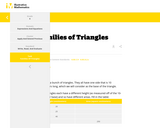
In this assessment, students explain why an inequality can have more than one solution.
- Subject:
- Mathematics
- Material Type:
- Assessment
- Provider:
- Howard County Public Schools
- Author:
- Howard County Public Schools
- Date Added:
- 04/23/2014


In this assessment, students explain why an inequality can have more than one solution.

In this assessment, students use variables to represent quantities that change in relation to one another and use a function to solve problems.

In this assessment, students use variables to represent quantities that change in relation to one another and use a function to solve problems.

In this assessment, students use variables to represent quantities that change in relation to one another and use a function to solve problems.

In this assessment, students use variables to represent quantities that change in relation to one another and use a function to solve problems.

In this assessment, students use variables to represent quantities that change in relation to one another and use a function to solve problems.

In this assessment, students use variables to represent quantities that change in relation to one another and use a function to solve problems.

In this assessment, students use variables to represent quantities that change in relation to one another and use a function to solve problems.

In this task, students find equivalent expressions by visualizing a familiar activity involving distance.

For this task, students use the commutative, associative, and distributive properties to decide which expressions are equivalent.

For this task, students find the number that makes each equation true.

This is a task from the Illustrative Mathematics website that is one part of a complete illustration of the standard to which it is aligned. Each task has at least one solution and some commentary that addresses important asects of the task and its potential use. Here are the first few lines of the commentary for this task: Take a square with area 1. Divide it into 9 equal-sized squares. Remove the middle one. What is the area of the figure now? Take the remaining 8 square...

This is a task from the Illustrative Mathematics website that is one part of a complete illustration of the standard to which it is aligned. Each task has at least one solution and some commentary that addresses important aspects of the task and its potential use.

For this task, students demonstrate their understanding of the meaning of a solution to an inequality.

For this task, students reason about the meaning of equations and the solution of an equation and make connections with operations with fractions and decimals.

This is a task from the Illustrative Mathematics website that is one part of a complete illustration of the standard to which it is aligned. Each task has at least one solution and some commentary that addresses important asects of the task and its potential use. Here are the first few lines of the commentary for this task: A penny is about $\frac{1}{16}$ of an inch thick. In 2011 there were approximately 5 billion pennies minted. If all of these pennies were placed in a s...

For this task, students use various approaches to solve a multi-step percentage problem.

In this task, students write an expression for the perimeter of a rectangle and use the expression to find the perimeter of a rectangle with a given length and width.

In this task, students determine the correct expression and how students may have been thinking when determining the perimeter of the rectangle.

This is a task from the Illustrative Mathematics website that is one part of a complete illustration of the standard to which it is aligned. Each task has at least one solution and some commentary that addresses important asects of the task and its potential use. Here are the first few lines of the commentary for this task: What is the last digit of $7^{2011}$? Explain. What are the last two digits of $7^{2011}$? Explain....